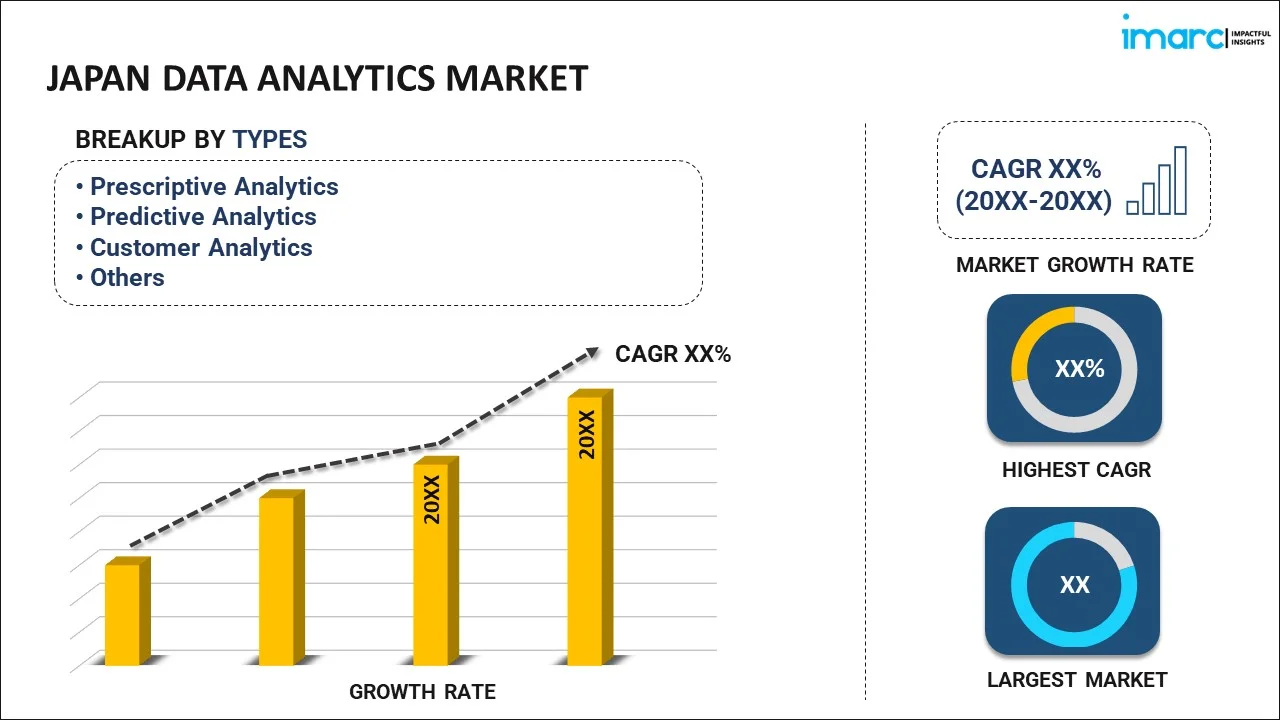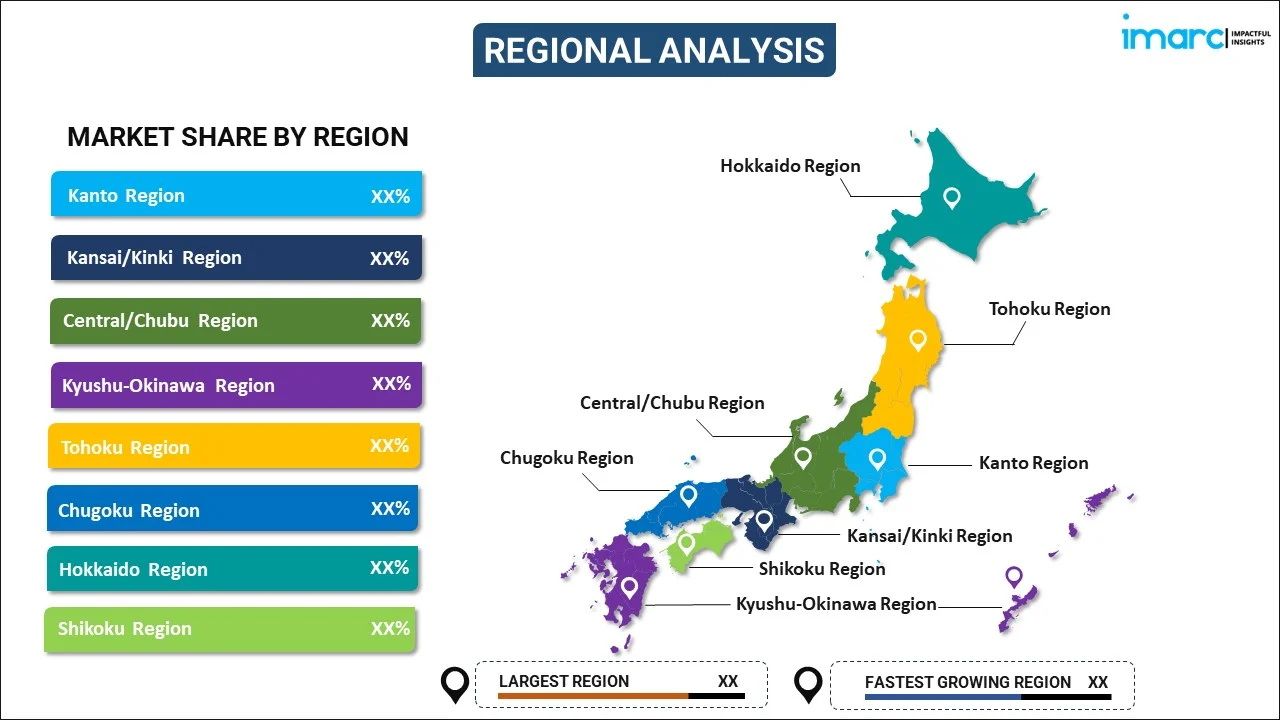
Japan Data Analytics Market Report by Type (Prescriptive Analytics, Predictive Analytics, Customer Analytics, Descriptive Analytics, and Others), Solution (Security Intelligence, Data Management, Data Monitoring, Data Mining), Deployment (Cloud-based, On-premises), Application (Supply Chain Management, Enterprise Resource Planning, Database Management, Human Resource Management, and Others), and Region 2025-2033
Market Overview:
Japan data analytics market size reached USD 4,392 Million in 2024. Looking forward, IMARC Group expects the market to reach USD 12,020 Million by 2033, exhibiting a growth rate (CAGR) of 11.8% during 2025-2033. The increasing demand for artificial intelligence and machine learning, which enable predictive and prescriptive analytics, allowing organizations to anticipate trends, automate processes, and make data-driven recommendations, is primarily driving the market.
|
Report Attribute
|
Key Statistics
|
|---|---|
|
Base Year
|
2024
|
|
Forecast Years
|
2025-2033
|
|
Historical Years
|
2019-2024
|
|
Market Size in 2024
|
USD 4,392 Million |
|
Market Forecast in 2033
|
USD 12,020 Million |
| Market Growth Rate 2025-2033 | 11.8% |
Data analytics refers to the process of examining massive data sets to derive meaningful insights and patterns. It involves collecting, cleaning, and transforming data into a usable format, then applying various statistical and computational techniques to uncover valuable information. Data analytics can be used in multiple fields, including business, healthcare, finance, and more, to solve problems, make informed decisions, and identify opportunities for improvement. There are different types of data analytics, including descriptive (summarizing past data), diagnostic (identifying the causes of past events), predictive (forecasting future trends), and prescriptive (providing recommendations for actions). It relies on tools and technologies such as statistical analysis, machine learning, data visualization, and data mining to extract insights and make data-driven decisions. In today's data-driven world, data analytics plays a crucial role in helping organizations optimize operations, improve customer experiences, and acquire a competitive edge by leveraging the power of data to drive informed decision-making.
Japan Data Analytics Market Trends:
The data analytics market in Japan is experiencing robust growth due to several key drivers. Firstly, the proliferation of digital data sources has significantly expanded the scope and demand for data analytics solutions. With the increasing use of smartphones, IoT devices, and online platforms, there is an exponential growth in the volume of data generated. Consequently, this abundance of data necessitates advanced analytics tools and techniques to extract valuable insights. Moreover, the competitive business landscape has spurred organizations to leverage data analytics for acquiring a competitive edge. Firms are increasingly recognizing the value of data-driven decision-making to optimize their operations, enhance customer experiences, and identify growth opportunities. This heightened awareness of the strategic benefits of data analytics has become a major driving force behind market growth. Furthermore, technological advancements, like machine learning and artificial intelligence, which enable businesses to perform more sophisticated and predictive analyses, are expected to drive the data analytics market in Japan.
Japan Data Analytics Market Segmentation:
IMARC Group provides an analysis of the key trends in each segment of the market, along with forecasts at the country level for 2025-2033. Our report has categorized the market based on type, solution, deployment, and application.
Type Insights:

- Prescriptive Analytics
- Predictive Analytics
- Customer Analytics
- Descriptive Analytics
- Others
The report has provided a detailed breakup and analysis of the market based on the type. This includes prescriptive analytics, predictive analytics, customer analytics, descriptive analytics, and others.
Solution Insights:
- Security Intelligence
- Data Management
- Data Monitoring
- Data Mining
A detailed breakup and analysis of the market based on the solution have also been provided in the report. This includes security intelligence, data management, data monitoring, and data mining.
Deployment Insights:
- Cloud-based
- On-premises
The report has provided a detailed breakup and analysis of the market based on the deployment. This includes cloud- based and on-premises.
Application Insights:
- Supply Chain Management
- Enterprise Resource Planning
- Database Management
- Human Resource Management
- Others
A detailed breakup and analysis of the market based on the application have also been provided in the report. This includes supply chain management, enterprise resource planning, database management, human resource management, and others.
Regional Insights:

- Kanto Region
- Kansai/Kinki Region
- Central/ Chubu Region
- Kyushu-Okinawa Region
- Tohoku Region
- Chugoku Region
- Hokkaido Region
- Shikoku Region
The report has also provided a comprehensive analysis of all the major regional markets, which include Kanto Region, Kansai/Kinki Region, Central/ Chubu Region, Kyushu-Okinawa Region, Tohoku Region, Chugoku Region, Hokkaido Region, and Shikoku Region.
Competitive Landscape:
The market research report has also provided a comprehensive analysis of the competitive landscape in the market. Competitive analysis such as market structure, key player positioning, top winning strategies, competitive dashboard, and company evaluation quadrant has been covered in the report. Also, detailed profiles of all major companies have been provided.
Japan Data Analytics Market Report Coverage:
| Report Features | Details |
|---|---|
| Base Year of the Analysis | 2024 |
| Historical Period | 2019-2024 |
| Forecast Period | 2025-2033 |
| Units | Million USD |
| Scope of the Report | Exploration of Historical and Forecast Trends, Industry Catalysts and Challenges, Segment-Wise Historical and Predictive Market Assessment:
|
| Types Covered | Prescriptive Analytics, Predictive Analytics, Customer Analytics, Descriptive Analytics, Others |
| Solutions Covered | Security Intelligence, Data Management, Data Monitoring, Data Mining |
| Deployments Covered | Cloud-based, On-premises |
| Applications Covered | Supply Chain Management, Enterprise Resource Planning, Database Management, Human Resource Management, Others |
| Regions Covered | Kanto Region, Kansai/Kinki Region, Central/ Chubu Region, Kyushu-Okinawa Region, Tohoku Region, Chugoku Region, Hokkaido Region, Shikoku Region |
| Customization Scope | 10% Free Customization |
| Post-Sale Analyst Support | 10-12 Weeks |
| Delivery Format | PDF and Excel through Email (We can also provide the editable version of the report in PPT/Word format on special request) |
Key Questions Answered in This Report:
- How has the Japan data analytics market performed so far and how will it perform in the coming years?
- What has been the impact of COVID-19 on the Japan data analytics market?
- What is the breakup of the Japan data analytics market on the basis of type?
- What is the breakup of the Japan data analytics market on the basis of solution?
- What is the breakup of the Japan data analytics market on the basis of deployment?
- What is the breakup of the Japan data analytics market on the basis of application?
- What are the various stages in the value chain of the Japan data analytics market?
- What are the key driving factors and challenges in the Japan data analytics?
- What is the structure of the Japan data analytics market and who are the key players?
- What is the degree of competition in the Japan data analytics market?
Key Benefits for Stakeholders:
- IMARC’s industry report offers a comprehensive quantitative analysis of various market segments, historical and current market trends, market forecasts, and dynamics of the Japan data analytics market from 2019-2033.
- The research report provides the latest information on the market drivers, challenges, and opportunities in the Japan data analytics market.
- Porter's five forces analysis assist stakeholders in assessing the impact of new entrants, competitive rivalry, supplier power, buyer power, and the threat of substitution. It helps stakeholders to analyze the level of competition within the Japan data analytics industry and its attractiveness.
- Competitive landscape allows stakeholders to understand their competitive environment and provides an insight into the current positions of key players in the market.
Need more help?
- Speak to our experienced analysts for insights on the current market scenarios.
- Include additional segments and countries to customize the report as per your requirement.
- Gain an unparalleled competitive advantage in your domain by understanding how to utilize the report and positively impacting your operations and revenue.
- For further assistance, please connect with our analysts.
 Inquire Before Buying
Inquire Before Buying
 Speak to an Analyst
Speak to an Analyst
 Request Brochure
Request Brochure
 Request Customization
Request Customization




.webp)




.webp)












